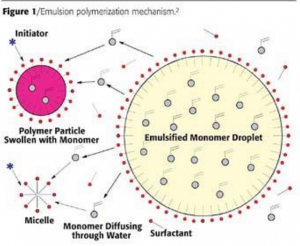This article will detail the fundamentals of emulsion polymerization. Emulsion polymerization was developed by The Goodyear Tire & Rubber Company in the 1920s. The emulsion-polymerization process results in a latex particle, which is a dispersion of polymer in water. Waterborne coatings that primarily use emulsion polymers are the largest type of coating technology used on a global basis and are expected to continue to grow as a percent of the total coatings market.
In emulsion polymerization, monomers are first dispersed in the aqueous phase. Initiator radicals are generated in the aqueous phase and migrate into the soap micelles that are swollen with monomer molecules. As the polymerization proceeds, more monomers migrate into the micelle to enable the polymerization to continue.
Since only one free radical is present in the micelle prior to termination, very high molecular weights are possible., on the order of 1,000,000 or higher. Unlike solution polymers, the viscosity of latexes are governed by the viscosity of the medium the particles are dispersed in (continuous medium). Chain transfer agents are added to control the molecular weight. The resultant emulsion particle is an oil in water emulsion. monomer in the aqueous phase.
A less commonly used emulsion technique called the inverse emulsion-polymerization process involves dispersing an aqueous solution of monomer in the nonaqueous phase.
Emulsion polymerization can occur using a batch process, semi-continuous process or continuous process. Commerciallatex polymers are made using a semi-continuous or continuous process rather than a simple batch process because the heat evolved in a simple emulsion batch process would be uncontrollable in a large reaction vessel. In the semi-continuous batch process, monomers and initiators are added in proportions and at a controlled rate so that rapid polymerization occurs. In this method, the monomer concentration is low, also called under-starved monomer conditions, to facilitate temperature control. It is also common to start the polymerization using a seed latex.
In the continuous process, the reaction system is continuously fed to, and removed from, a suitable reactor at rates such that the total volume of the system undergoing reaction at any instant is constant.
To read the rest of the article, written by Ron Lewarchik, please click here to head over to UL Prospector.
__________
Ron Lewarchik, Author of article & President of Chemical Dynamics
As a contributing writer, Ron pens articles on topics relevant to formulators in the coatings industry. He also serves as a consultant for the Prospector materials search engine, advising on issues related to optimization and organization materials within the database.


